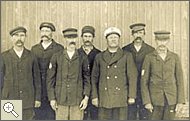|
|
 |
 |
 |
|
Background Essay |
|
Essay Home
-
Wing Warping
-
Why Kitty Hawk?
-
Breakthrough
-
Takeoff
-
History's First Drafts
|
 |
 |
 |

The optimum wind speed for the glider’s wing design, according to air pressure tables published by Otto Lilienthal, was between fifteen and twenty miles an hour. From the U.S. Weather Bureau, the Wrights learned that the weather station at Kitty Hawk, on the Outer Banks of North Carolina, was one of the windiest places in the country. The average wind speed was about sixteen miles an hour in September. They decided to make the tests in September of 1900.
Kitty Hawk had other things going for it. It had high, treeless hills for launching the glider and broad sand beaches for soft landings. The Wrights made a trip there every year between 1900 and 1903, each time testing an improvement on their design. They lived on their own on the dunes, first in a wind-whipped tent, then in a hand-built shed.
Kitty Hawk postmaster William J. Tate later wrote that the people of this remote outpost of the South regarded the visitors as “a pair of harmless nuts, not dangerous, but simply crazy on the subject of flying.” Nonetheless, the Wrights found themselves with many volunteer helpers at Kitty Hawk—a ground crew of sorts, which came to include men from the U.S. Life-Saving Service, an antecedent of the Coast Guard.
The Wrights were pleased with the system of control on the 1900 glider, but with a pilot on board they could get off the ground only in dangerously strong winds. When they returned to Kitty Hawk the next year, they tested larger and more deeply curved wings. The results were again disappointing. Orville wrote that the tests confirmed “the belief already formed that the accepted tables of air pressure were not to be altogether relied upon.”
|
 |
 |
 |
 |

The Life-Saving Service
|
 |
 |

Men from the Life-Saving Service at Kill Devils Hills, North Carolina
|
 |
 |
 |
|




|
|
|

